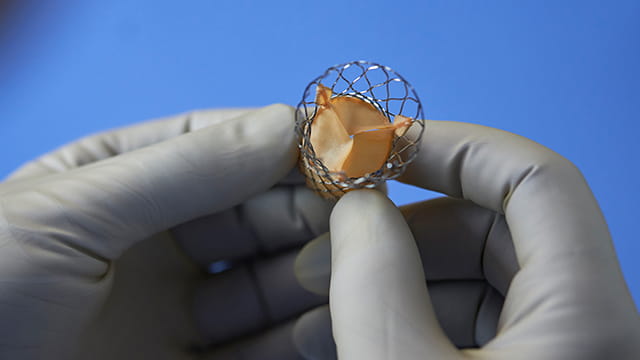TAVI Shows Durable Benefits in Three-Year, Low-Risk Clinical Trial
April 19, 2023 - Eden McCleskey
A new study reporting three-year results from the Evolut self-expanding valve clinical trial found that transcatheter aortic valve implantation (TAVI) compared favorably to surgery as a treatment for severe aortic stenosis among patients at low surgical risk.
Surgical aortic valve replacement (SAVR) is an open-heart surgery that involves stopping the heart to insert an artificial valve. TAVI is a minimally-invasive procedure in which the only incision is a small hole in the groin where a catheter is inserted.
The Evolut trial confirms earlier results demonstrating TAVI valves’ excellent performance among high and intermediate-risk patients, expanding those findings to a younger, generally healthier population of patients for whom long-range durability is an important concern.
Approximately 1,400 patients were enrolled in the trial and randomly assigned to a treatment group, with 51.6% undergoing TAVI (mean age 74.1 y, mean STS score 2.0%) and 48.4% undergoing SAVR (mean age 73.7 y, mean STS score 1.9%).
The study’s composite primary endpoint of all-cause mortality or disabling stroke occurred in 7.4% of the TAVI patients and 10.4% of the surgical patients (HR 0.70; 95% CI; p=0.051), continuing similar trends demonstrated in the low-risk trial’s one and two-year results and the high and intermediate-risk trials’ one, three and five-year results.
The incidence of mild paravalvular regurgitation (20.3% TAVI vs. 2.5% surgery) and pacemaker placement (23.2% TAVI vs. 9.1% surgery) were lower in the surgery group. Rates of moderate or greater paravalvular regurgitation for both groups were less than 1% and not significantly different. Patients who underwent TAVI showed significantly improved valve hemodynamics (mean gradient 9.1mmHg in TAVI vs. 12.1mmHg in surgery; p<0.001) at three years.
“So far, TAVI’s excellent short-term outcomes have been well maintained over time, affirming its role as a promising option for younger patients with low rates of comorbidities and potentially several more decades of active, productive life to enjoy,” says Dr. Michael Reardon, a Houston Methodist cardiothoracic surgeon and co-principal investigator for the trial.
The durability question
TAVI’s initial benefits are obvious. As Dr. Reardon says, "No matter who you are, you're going to go home faster, recover faster and feel relief from the symptoms of aortic stenosis faster."
A question that remains is valve durability versus life expectancy, a concept that has been termed “lifetime management.” Ideally, the durability of a valve should outlast the life expectancy of the patient.
"TAVI was initially developed for patients who were deemed too frail to undergo surgery, and our initial high-risk trial had a mean patient age of 83," says Dr. Neal Kleiman, a Houston Methodist interventional cardiologist and contributing author on the CoreValve and SURTAVI trials. "In that population, there wasn't as much concern about whether the valves would last 15, 20 years or more."
Over the course of the past decade, however, the encouraging safety profile reported in high-risk, intermediate-risk and low-risk clinical trials led to a progressive expansion of criteria so that surgical risk is no longer a determining factor.
A shared decision
TAVI has evolved into the dominant treatment for severe aortic stenosis, thanks to several clinical trials proving it to be a safe and effective alternative to SAVR.
But because the durability of the TAVI valves was unknown, surgeons weren’t sure whether to recommend the procedure to younger patients, who likely might need follow-up procedures.
Current clinical guidelines recommend SAVR for patients younger than 65 or with a life expectancy of more than 20 years. For patients over age 80 or with a life expectancy of less than 10 years who are suitable for a transfemoral TAVI, TAVI is recommended.
Between the ages of 65 and 80, the guidelines suggest a shared decision-making process, balancing the risks and unknowns about how long the valves will last with the patient's needs and wishes.
Five-year results
Results from previous studies showed that the hemodynamic benefits of the Medtronic valves were maintained at five years with an excellent safety profile and stable valve performance in symptomatic patients with severe aortic stenosis.
Five-year results from the intermediate-risk SURTAVI study showed that all-cause mortality was similar between TAVI and SAVR (30.0% for TAVI versus 28.7% for SAVR; p=0.55), while rates of disabling stroke were also similar (4.1% for TAVI versus 5.8% for SAVR, p = 0.12). The TAVI valves continued to demonstrate durable longevity, with better mean aortic valve gradients (8.6 mm Hg vs. 11.2 mm Hg; p<0.001) at five years.
Overall, these figures differed very little from those seen shortly after implantation. Additionally, valve thrombosis remained uncommon for both TAVI and SAVR groups.
Houston Methodist Hospital was the lead enrolling site in the high-risk (CoreValve), intermediate-risk (SURTAVI) and low-risk (Evolut) clinical trials. Dr. Reardon has served as national principal investigator for the series while Dr. Kleiman was a contributing author.


